Landscape lighting transcends mere aesthetics, it’s a multifaceted tool that significantly enhances the functionality and safety of your home. Envision a pathway illuminated just enough to ensure safe passage or a yard that’s subtly lit to deter unwelcome visitors. This isn’t about arbitrary illumination but rather a strategic approach to integrating security, safety, and elegance into your home’s exterior.
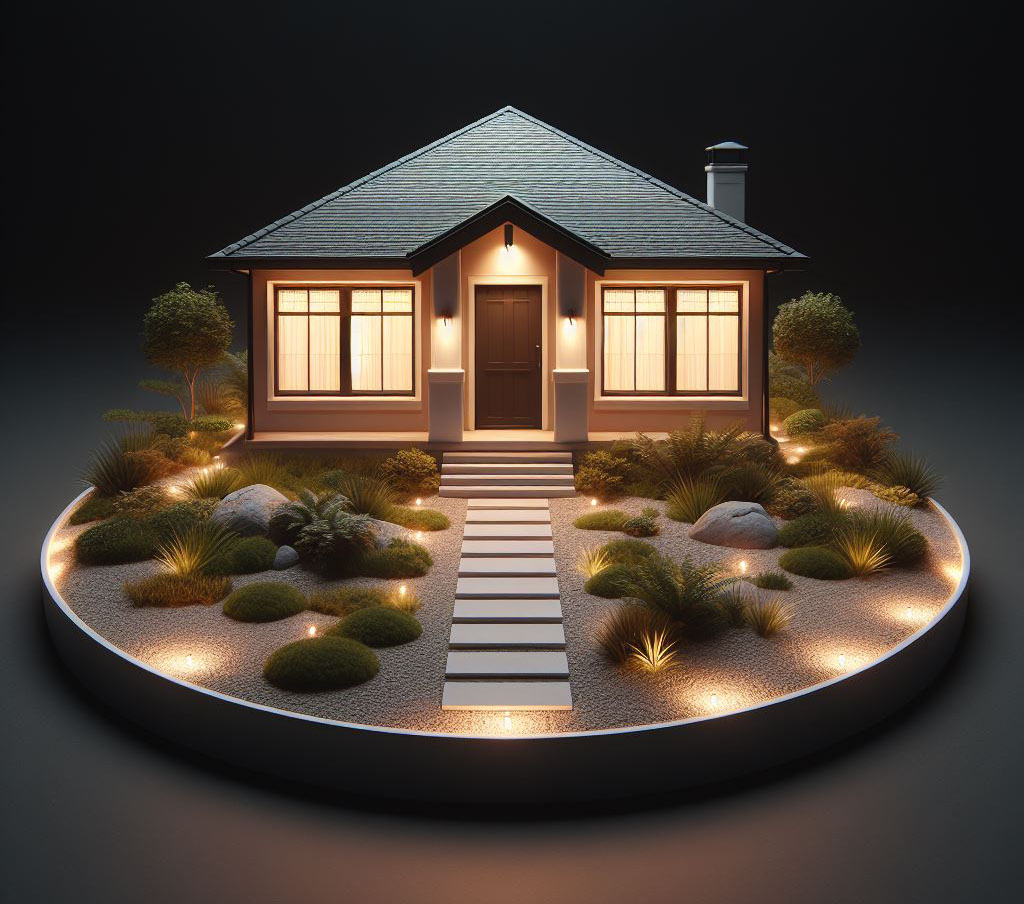
Understanding the Basics of Landscape Lighting:
Diving into the essentials, landscape lighting involves a thoughtful blend of various techniques, each serving a unique purpose:
- Uplighting: This technique creates drama and draws attention to the proud features of your landscape—trees, architectural details, or textured walls. Uplighting infuses a sense of grandeur and depth into your space.
- Downlighting: On the subtler side, downlighting is the preferred approach for areas where functionality is key. It provides a gentle wash of light over walkways or patios, ensuring visibility without the harshness of direct light.
- Accent Lighting: This is where precision comes into play. Accent lighting is about highlighting the intricacies of your landscape—be it a water feature, sculpture, or an exquisite collection of flora.
When considering bulbs, longevity and efficiency are paramount. LED lights stand out for their durability and energy efficiency, ensuring a sustainable and cost-effective solution. For those inclined towards eco-friendly options, solar lighting presents an attractive alternative, merging environmental consciousness with aesthetic appeal.
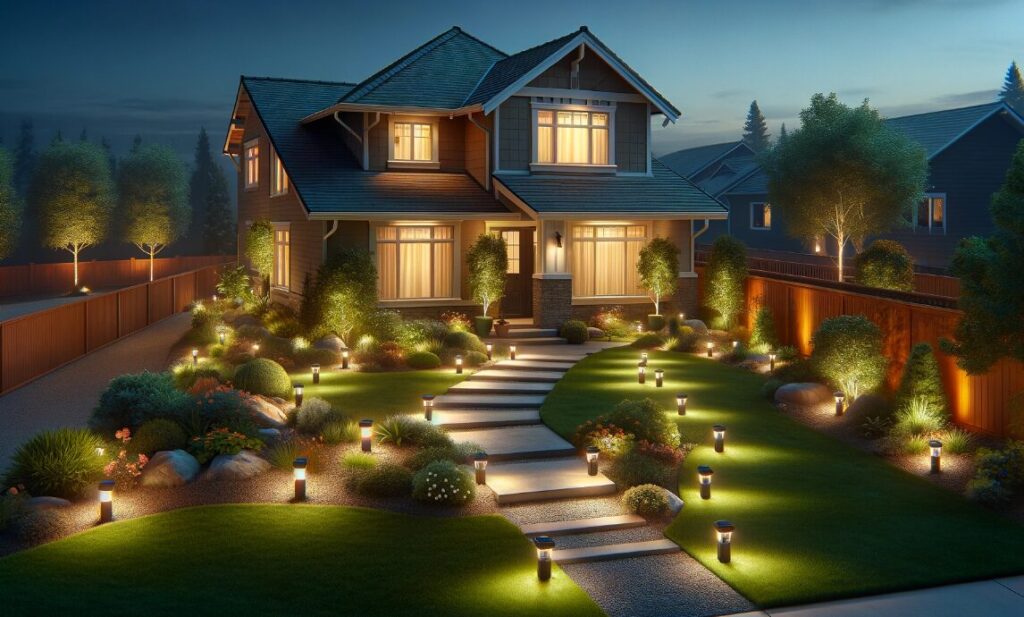
Planning Your Landscape Lighting Project:
Embarking on a landscape lighting project requires meticulous planning and a keen eye for detail:
- Sketch it Out: Begin with a comprehensive sketch of your property. Identify and mark key elements like pathways, distinctive garden features, and the architectural nuances of your home. This initial step is akin to laying the foundation—it’s about visualizing the potential and creating a roadmap to success.
- Function vs. Fashion: Striking a balance between practicality and aesthetics is crucial. Your lighting should serve its primary function—security and visibility—while also complementing and enhancing the natural beauty of your outdoor space.
- Balance is Key: The art of landscape lighting lies in the balance. Over-illumination can overwhelm the senses and detract from the beauty of your space, while insufficient lighting can leave areas feeling neglected and unwelcoming. The goal is to achieve a harmonious blend that accentuates, illuminates, and invites.
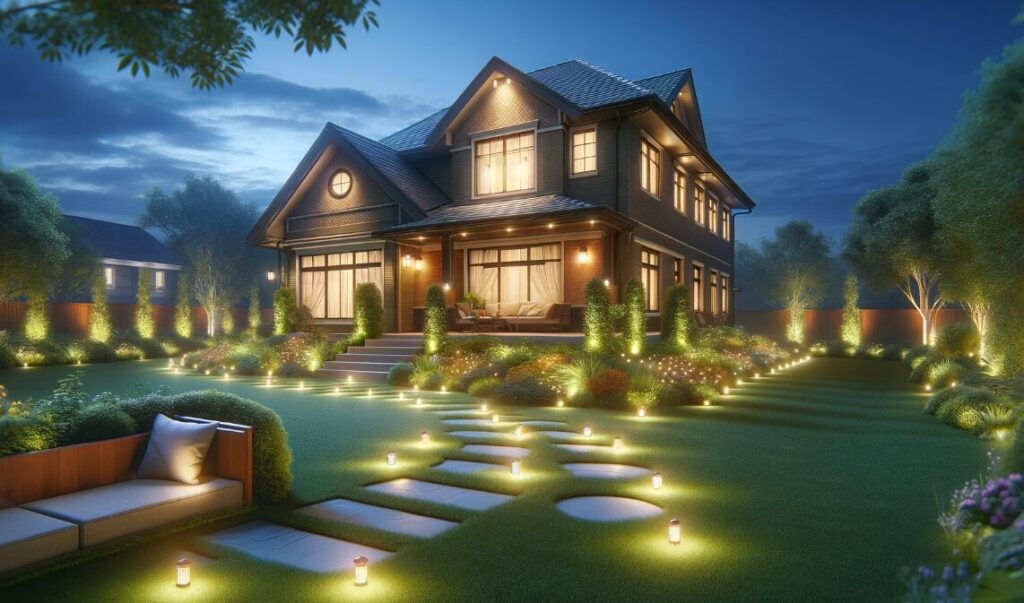
Types of Landscape Lighting Fixtures
In landscape lighting, every fixture serves a distinct and deliberate purpose. Whether it’s casting a glow or carving out a shadow, the choice of fixture is paramount.
- Uplighting Fixtures: These are integral for adding depth and drama. Positioned strategically, they transform trees, architectural elements, and statues from mere features to striking focal points. It’s essential to choose fixtures that not only withstand the elements but also offer the flexibility to adjust intensity and angle.
- Downlighting Fixtures: These fixtures provide a more subdued ambiance, mimicking the serene glow of moonlight. Perfect for walkways or outdoor seating areas, they offer safety and tranquility. Opt for fixtures that offer even light distribution and are discreet in design, blending seamlessly into the surroundings.
- Accent Lighting Fixtures: Precision is the game here. These fixtures spotlight the unique attributes of your landscape, whether it’s a water feature or an intricate garden design. The key is to select fixtures that offer pinpoint accuracy in light direction while maintaining a harmonious balance with the overall lighting scheme.

Installation Tips and Techniques
Correct installation is the bedrock of effective landscape lighting. It’s not just about aesthetics but also longevity and safety.
- Plan Meticulously: Every fixture should be purposefully placed, serving both a functional need and a design desire. Map out your layout meticulously, factoring in every light source and its intended effect.
- Prioritize Safety: Electrical installations outdoors require cautious handling. Ensure the power is off during installation and consider consulting a professional electrician for complex setups.
- Choose Quality Materials: Opt for cables and fixtures rated for outdoor use. They need to withstand temperature fluctuations, moisture, and other environmental challenges.
- Ensure Proper Waterproofing: Outdoor settings demand fixtures and connections that are resistant to water. Ingress of moisture can lead to failure and safety hazards.
- Conduct a Test Run: Before finalizing the installation, test your setup during the evening. It’s the best way to ensure that every light casts the intended effect and adjustments can be made if necessary.
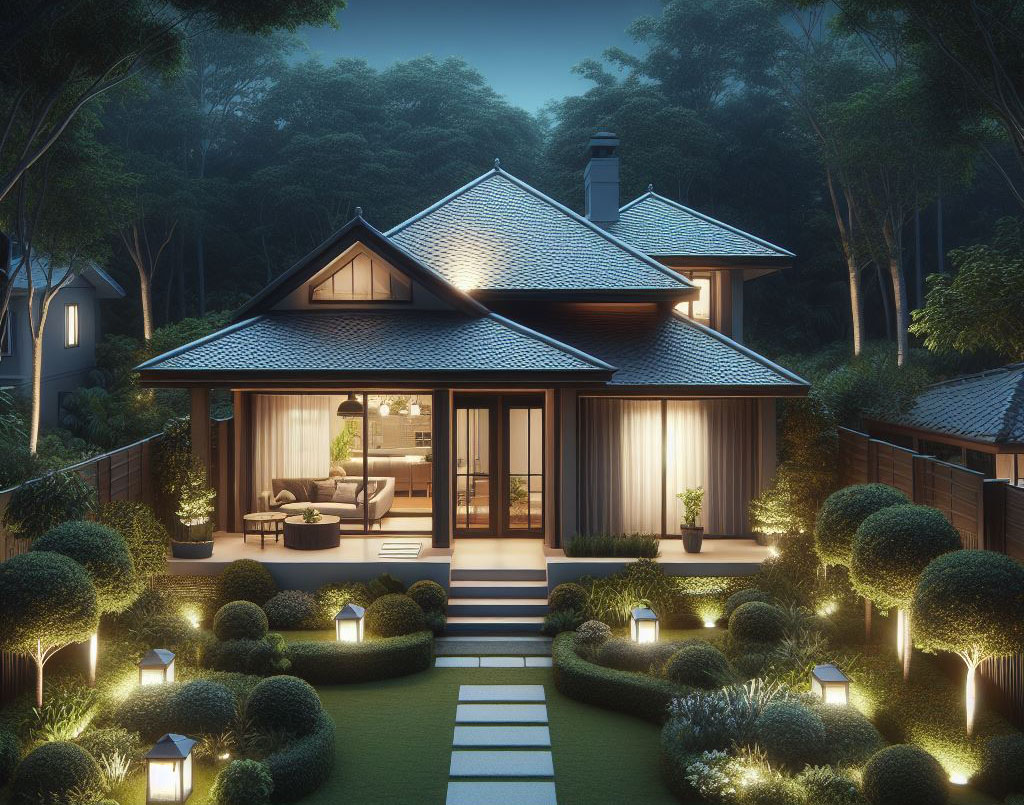
Designing with Light: Creative Ideas and Strategies
Approaching your landscape lighting design is akin to painting a picture with light, with every beam and shadow contributing to the overall scene.
- Utilize Shadows Thoughtfully: Light shapes spaces not just by illumination but also by the shadows it casts. Use these shadows to create depth, accentuate textures, or add a layer of intrigue to your landscape.
- Master the Art of Uplighting: Uplighting is more than just illumination, it’s about sculpting the space. The right angle, intensity, and fixture can elevate an ordinary feature into the centerpiece of your landscape.
- Strategize for Curb Appeal: The front of your home is your introduction to the world. Use a combination of uplighting and pathway lighting to draw attention to the best features, guide visitors, and offer a warm welcome. Remember, the goal is to create an inviting, harmonious entrance that complements the overall aesthetics of your property.
Maintenance and Troubleshooting
Maintaining your landscape lighting is not just about preserving its beauty, it’s about ensuring its functionality and longevity. Regular, methodical maintenance can prevent most common issues and extend the life of your lighting.
- Fixture Cleaning: Regularly clean lenses and fixtures to prevent light degradation. Dirt and debris can significantly diminish light output and alter the intended lighting effect.
- Securing Fixtures: Periodically check and tighten any fixtures that may have become loose due to weather or ground movement. A stable fixture ensures consistent lighting and prevents damage.
- Bulb Replacement: Monitor your lights for any signs of dimming or burnout. Replacing bulbs promptly ensures your space remains well-lit and inviting.
Troubleshooting Common Issues:
- Non-Functional Lights: Always start with the basics. Check power sources and ensure all switches are on. Inspect transformers and wiring for any signs of disconnection or damage.
- Dim or Flickering Lights: This often indicates a power supply issue. Ensure your transformer isn’t overloaded and that all connections are secure and corrosion-free. Clean fixtures and replace bulbs if necessary.
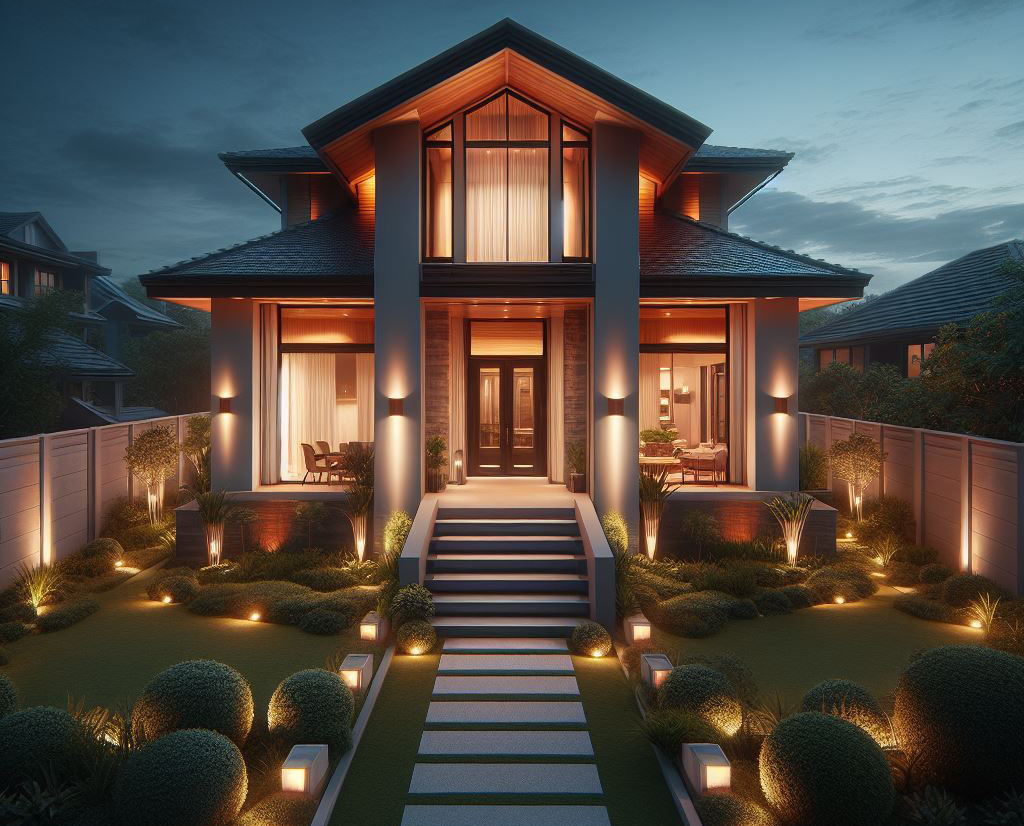
Advanced Considerations
Embracing advanced technology in landscape lighting not only elevates the functionality of your space but also contributes to sustainability and convenience.
- Automated Systems: These systems provide convenience and efficiency by automatically adjusting lighting based on the time of day or occupancy, reducing energy consumption.
- Remote Control and Customization: Modern systems allow you to control and adjust your lighting remotely, offering the flexibility to change lighting scenes and colors to suit any occasion or mood.
- Color-Changing Features: These features allow you to adapt the ambiance of your outdoor space to match seasons, holidays, or personal preferences, making your space versatile and dynamic.
Environmental Considerations:
- Minimizing Light Pollution: Thoughtfully aimed and shielded lights prevent unnecessary light spill into the night sky or neighboring properties, preserving the natural ambiance and respecting community spaces.
- Energy-Efficient Options: Opting for LED and solar-powered lights reduces energy consumption and operational costs, contributing to a more sustainable and environmentally friendly lighting solution.
FAQ Section
Consider the purpose and ambiance of each area. Warm lights (lower Kelvin) create a cozy, welcoming atmosphere, ideal for relaxation areas. Cooler, brighter lights (higher Kelvin, higher lumens) offer clarity and are best for security and task-oriented spaces.
Absolutely. LEDs are remarkably energy-efficient, consuming a fraction of the power of traditional bulbs while offering longevity. Solar options are also viable, harnessing renewable energy and offering a sustainable lighting solution.
Proper installation is crucial. Use fixtures and cables rated for outdoor use, ensure all connections are watertight, and adhere to electrical safety standards. Regular maintenance further ensures the continued safety and functionality of your lighting.
It’s about strategic placement. Utilize brighter lighting in areas requiring security or visibility. Complement these with softer, ambient lighting to enhance the beauty of your space without compromising safety.
A routine inspection every few months is advisable. Check for and rectify any issues with fixtures, bulbs, or wiring. Regular cleaning and timely bulb replacement ensure your lighting remains as effective and beautiful as intended.
